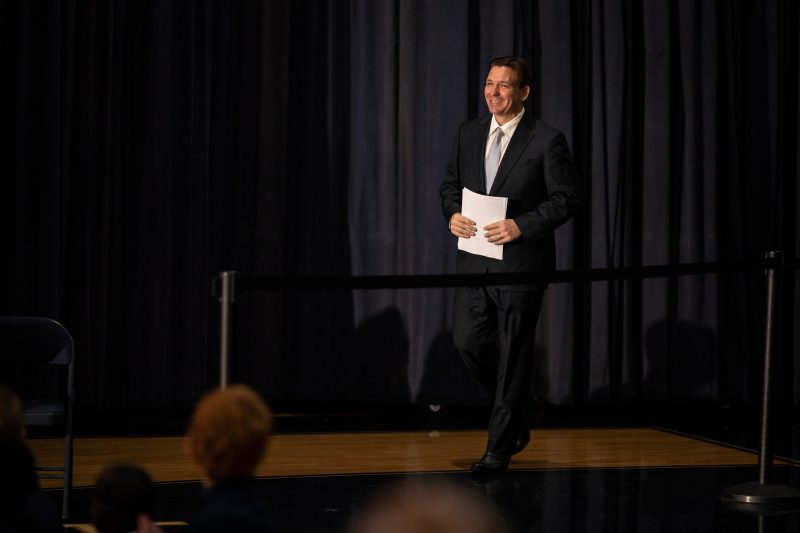As is usually the case in politics — and otherwise in life — there is room for more than one person to be embarrassed after a calamitous mistake.
The 20 minutes of fumbling that preceded the formal announcement by Florida Gov. Ron DeSantis of his bid for the 2024 Republican presidential nomination was not, in itself, DeSantis’s fault. It was a technical failing on the part of Twitter, DeSantis’s chosen venue, and it was irreducibly the fault of Twitter’s new owner, Elon Musk. Since assuming control of the social media platform, Musk has had a habit of overpromising and under-delivering, and his site’s failure to accommodate a crowd of relatively modest scale (by internet standards) lands on his shoulders.
When DeSantis said the magic words — “I am running for president of the United States” — only 108,000 people were tuned in.
Musk claimed that Twitter’s servers were overloaded, the sort of thing that might have been caught had the team prepared for the event, which it reportedly didn’t. But while that stumble is attributable to Musk, blame for the repercussions of it can extend further. After all, it was not unpredictable.
In the abstract, it’s easy to see why DeSantis’s team would have found the unique launch announcement appealing. Musk has more than 100 million Twitter followers, and an announcement on Twitter shows that DeSantis is willing to buck tradition, etc. It is the job of DeSantis’s team and a core function of a smoothly run campaign, however, to ensure that clever ideas are feasible ones. Perhaps this one was vetted as thoroughly as possible and still failed. Nonetheless, the perception is that the DeSantis campaign began with a highly visible mistake.
Focusing on the technical side actually understates the mistakes the campaign made at launch. But we’ll come back to that in a second. First, let’s assess why the mistake of the Twitter rollout was particularly acute.
DeSantis is running as a competent administrator, as the guy who will do all of the things former president Donald Trump would do but without the baggage and toxicity. He is positioned well, running in second behind Trump, making him the leading candidate in one of the two viable lanes for the GOP nomination. Those lanes are not the traditional ones — support from evangelical Christians and from moderates — but instead “Trump” and “not Trump.” Trump has a lock on the former and DeSantis hopes to retain a clear path in the latter. This is the lesson many donors and Trump-hostile activists learned in 2016: You need to consolidate early around someone other than Trump to ensure that the former president can’t win states with 30 percent of the vote.
Over the past few months, though, DeSantis has been losing ground to Trump in national polling. His campaign has just begun in a formal sense, but he’s been campaigning informally during that period. And unsuccessfully. He’s been criticized as being overly stiff and awkward. He spurred an angry reaction when he responded to a question from Tucker Carlson by adhering to Carlson’s view of the war in Ukraine.
So imagine you’re a big donor watching the past few months’ developments and becoming more nervous about whether DeSantis can beat Trump even if no one else is running. You tune in to Twitter on Wednesday (after figuring out how to tune in to Twitter). And what you’re presented with is a widely ridiculed fumble.
And that was just the start. The actual conversation with Musk expanded to include a coterie of Musk-adjacent or Musk-obsequious others. It was a discussion that featured relatively little of the new candidate and a lot of the standard Muskworld agitation.
It was also exceptionally dry. It had all of the charm of listening to a college debate club in which everyone generally agrees on everything. And not listening to it in person, mind you, but over the radio. Instead of showing any appealing side to DeSantis, it reinforced the opposite.
Importantly, the campaign’s other decisions were similarly dubious. At launch, his fundraising website was poorly designed and lacked polish, the sort of detail that you need to ensure you’ve nailed well before the day it is required. A video released to try to leverage the Twitter fiasco was shaky with low-quality audio. Campaigns typically blanket the media with emails related to big events either of their own or their opponents’, but the only messages I received as DeSantis’s launch was underway came from Trump’s campaign — and they were not flattering.
DeSantis needed to do better than this, in all regards. Let’s set aside the fact that Trump is in a stronger position now than he was before primary voting in 2016, reducing the likelihood that a candidate with consolidated support could undercut him. If you do think that you need one alternative to be your best bet to unseat Trump, did Wednesday convince you that DeSantis was the guy for that role?
On Thursday morning, DeSantis’s team announced that he would have a traditional campaign kickoff event in Iowa next week. Perhaps — probably! — that one will go better, with his advance team able to ensure that the venue is adequate, a crowd has been arranged and all the microphones work.
It won’t change that Wednesday unfolded the way it did. And one bit of unsolicited advice for the campaign: If a self-involved billionaire offers to do the introduction at that event, decline.








